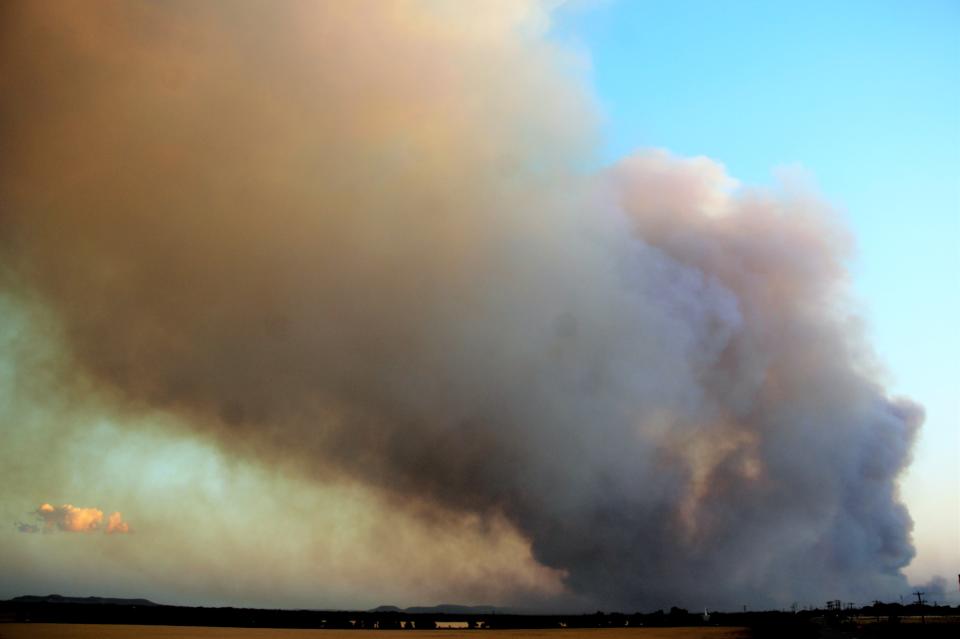Forest service cites weather, warns of potential wildfires across Texas through weekend
The Texas A&M Forest Service warns that hot and dry conditions across Texas will create a high potential for wildfires through the weekend.
The forest service reported that, over the 10 days ending on Tuesday, the agency had responded to about 100 wildfires that had burned nearly 18,000 acres across Texas. On Wednesday, the Texas A&M Forest Service resources responded to 16 wildfires that burned 607 acres.
Drought conditions have expanded in Texas for the sixth consecutive week, according to data released Thursday by the U.S. Drought Monitor. About 99.2% of the state is experiencing drought — from "abnormally dry," the lowest level of drought, to "exceptional drought," the most severe level. That's an increase from about 87% at the start of the year, drought data show.

The U.S. Drought Monitor, a joint effort of the National Drought Mitigation Center, the U.S. Agriculture Department and the National Oceanic Atmospheric Administration, estimates that at least 22.8 million Texans live in drought-stricken areas. Drought data also indicate that 2022 to date is the state's sixth-driest year during the past 128 years.
Exceptional drought — typified by crop loss and extreme sensitivity to fire danger — rose from 16.1% last week to 21.3% of Texas. The most severe drought conditions that have plagued the Texas Panhandle and Big Bend in West Texas have expanded into the Hill Country just west of Austin — in Blanco and Gillespie counties — and into western Hays County.
The forest service earlier this week said some communities in Texas have an increased potential for large wildfires that could be difficult to control. Vulnerable metro areas include Austin, San Antonio, Waco, Wichita Falls, Fort Worth, San Angelo and Abilene. In East Texas, places susceptible to large wildfires include areas near Athens, Tyler, Longview, Palestine and Huntsville.
Continued triple-digit temperatures reduce the moisture in vegetation across the state, which increases the possibility of wildfires this week. But even thunderstorms that could produce rain could make the issue worse.
More: Person dies in South Austin apartment fire
“Wildfire ignitions due to lightning will be possible because of the underlying drought and vegetation dryness," said Luke Kanclerz, Texas A&M Forest Service fire analyst. "Increased wind speeds from nearby thunderstorms can cause a sudden increase in fire activity, creating safety concerns for firefighters.”
Austin Fire Department Division Chief Thayer Smith said the combination of extreme heat and expanded drought conditions in Austin means that brush fires are more likely to happen this summer. As fire fuels like tree branches dry out, firefighters are worried about critical fire danger for the rest of the year if Austin doesn’t get rain soon, he said.
Over the July 4 holiday weekend, Austin Fire Department crews and various Travis County fire departments responded to 133 grass, brush, dumpster or trash fires from the night of July 4 through noon July 5. According to the department, they also responded to 10 structure fires, but most of the fires resulted in either no injuries or little damage.
"The fireworks are the cause of the fires, but the recent heat that dried out all the grass made everything dry and receptive to the fireworks, and then the fireworks were the cause of the fire, but the ongoing drought is a big deal," Smith said.
To prevent brush fires, Smith urges people to not use remaining fireworks after the holiday and to use caution with any other activities that can potentially spark a fire, such as welding or disposing of cigarette butts and barbecue ashes.
According to a Texas A&M Forest Service spokesperson, human activities cause nine out of 10 wildfires, which means those fires are preventable. The forest service encourages Texans to follow these safety measures:
From science fiction to reality: Austin's Apptronik humanoid robot
Check with local government officials for burn bans or other burning restrictions.
Avoid parking or idling in tall, dry grass. Catalytic converters can get hot enough to ignite the grass under a vehicle.
Ensure chains and other metal parts aren’t dragging from your vehicle — they can throw sparks.
Avoid placing a grill near flammable vegetation or materials, never leave the grill unattended and ensure coals are completely extinguished after using the grill.
Get more summer wildfire prevention information on the forest service's website
The forest service said homeowners should take a proactive approach to wildfire prevention and mitigation to increase their own safety and their home’s likelihood of survival during a catastrophic wildfire. The service recommends using fire-resistant landscaping, fire-resistant construction, improving access for emergency responders and using resources from its website.
Austin already has a burn ban ordinance that prohibits outdoor burning and trash burning in the city. The Austin metro area counties — Travis, Williamson, Hays, Caldwell and Bastrop counties — also adopted burn bans because of low rainfall and unseasonably high temperatures. Smith said he suspects the bans will stay in place for most of the summer and maybe for the rest of the year.
The Texas A&M Forest service burn ban map shows 209 of the 254 Texas counties currently are under a burn ban.
This article originally appeared on Austin American-Statesman: Forest service cites weather, warns of wildfire potential across Texas

